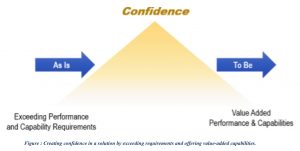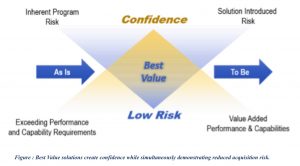How to Win with Risk
I recently attended a conference where an important government technology leader said to industry, “Please don’t come to my office and ask me what is keeping me awake at night! It shows me you don’t understand me or my organization.” He went on to explain that there are lots of things that keep him up at night. His job was to find solutions to those problems. His office puts out plenty of information about their issues and challenges. So, if you want a meeting with him, bring ideas that will deal with the risks so he can succeed.
When proposing solutions in government acquisitions, it is important to do your homework and embrace risk as part of your solution. Many companies avoid discussing risk at all. Part of the reason for this is that the government’s requirements address the risks that concern the government; therefore, they do not need to address risk further because it might suggest that the government doesn’t know its business. Others will claim they have a “low risk” or “no risk” solution so they do not need to discuss risks. Both of these companies miss the point that there are real risks that are worrying government decision-makers, and they want to work with companies that see, understand, and will confront these risks, which will lead to a greater probability of program success.
 Proposals that win best value procurements have numerous strengths. Strengths are usually described as features of the proposed solution that exceed the requirements in ways that the reviewer recognizes are beneficial to the government. We often think of it as shown in Figure 1. We know that customers want to move from their current “as is” environment to their desired, “to be” environment. To the degree our proposals demonstrate a balance of features that exceed performance and capability requirements and those that are value-adds, a proposal creates confidence in the mind of the reviewer.
Proposals that win best value procurements have numerous strengths. Strengths are usually described as features of the proposed solution that exceed the requirements in ways that the reviewer recognizes are beneficial to the government. We often think of it as shown in Figure 1. We know that customers want to move from their current “as is” environment to their desired, “to be” environment. To the degree our proposals demonstrate a balance of features that exceed performance and capability requirements and those that are value-adds, a proposal creates confidence in the mind of the reviewer.
For many companies, that is the end of the story. Yet, confidence that the solution will meet and exceed the requirements does not mean that you have addressed all the concerns of the acquisition. The reality of project execution is that there will be risks that turn into issues. Some are inherent to the type work being performed. Your solution might even be aimed at solving some of them. On the other hand, your approach could introduce a measure of uncertainty into the reviewer’s mind—risks associated with your solution. If you do not directly address these two types of risks in your solution, you could plant doubt in the mind of your reviewer. However, as shown in Figure 2, when you simultaneously create high confidence through a well-articulated solution and demonstrate how that solution reduces the acquisition risks, you create a “diamond opportunity” for best value.
 For example, consider the growing popularity of virtual desktop infrastructure (VDI). An agency might look for a VDI solution because it solves a configuration management issue they are having. Offering a remote VDI might be a great feature to offer if it will reduce agency infrastructure costs. However, the risk of remote VDI is that if connectivity goes down, people cannot work (Inherent program risk). Your solution might offer the ability to operate from a stored copy on user’s machine if connectivity is lost, solving the program risk, but creating a synchronization risk (a solution created risk). Having a feature that resynchronizes when connectivity is restored would be a feature that mitigates the solution risk.
For example, consider the growing popularity of virtual desktop infrastructure (VDI). An agency might look for a VDI solution because it solves a configuration management issue they are having. Offering a remote VDI might be a great feature to offer if it will reduce agency infrastructure costs. However, the risk of remote VDI is that if connectivity goes down, people cannot work (Inherent program risk). Your solution might offer the ability to operate from a stored copy on user’s machine if connectivity is lost, solving the program risk, but creating a synchronization risk (a solution created risk). Having a feature that resynchronizes when connectivity is restored would be a feature that mitigates the solution risk.
Customers want great solutions, but they are not so naïve as to believe that there are no risks or issues to be faced in their programs. They also know that every solution has its own set of challenges. When you intelligently discuss how your solution manages the government’s risks associated with a procurement, you will exceed the requirements of the acquisition in a way that is beneficial to the government – creating strengths and leading to a best-value offer. Well-articulated risk events that discuss how likely they are to occur, potential impacts to contract performance and credible mitigations are a best practice in demonstrating complete understanding of the requirement.
Dwayne Baptist, Managing Director at Lohfeld Consulting Group
Dwayne brings 30 years’ experience in the information technology and service delivery sector, with 25 years’ experience in capture and proposal development. An expert Proposal Manager, Orals Coach and Color Reviewer, he is a preeminent proposal strategist and solution architect. He has worked across off of DoD, many parts of DHS, and numerous civilian Federal Agencies. He has also led proposal efforts at the state and local level.
Prior to joining Lohfeld Consulting Group, Dwayne has served in senior leadership roles in a variety of large and small companies. He has led efforts to win major IDIQ vehicles with ceilings as high as $10 billion, including assembling winning teams to enter new markets that subsequently won significant task order revenue. As president of Dwayne Baptist and Associates, he combined capture and proposal development consulting with executive coaching to help leaders and organizations develop the business processes needed to quickly and reliably capture, bid, and win new work, and to protect incumbent work.
Lohfeld Consulting Group has proven results specializing in helping companies create winning captures and proposals.
As the premier capture and proposal services consulting firm focused exclusively on government markets, we provide expert assistance to government contractors in Go-to-Market Strategy, Capture Planning and Strategy, Proposal Management and Writing, Capture and Proposal Process and Infrastructure, and Training. In the last 3 years, we’ve supported over 550 proposals winning more than $135B for our clients—including the Top 10 government contractors. Lohfeld Consulting Group is your “go-to” capture and proposal source! Start winning by contacting us at www.lohfeldconsulting.com and join us on LinkedIn, Facebook, and Twitter.
Paperback or Kindle
10 steps to creating high-scoring proposals
by Bob Lohfeld
contributors Edited by Beth Wingate
Subscribe to our free ebrief
Teaming friends, frenemies, and enemies—12 tips to mitigate harmful effects
Did you know that contracting officers spend up to 20% of their time mitigating disputes between teaming partners? In an informal poll we conducted on LinkedIn last month, 40% of respondents classified their teaming partners as “frenemies” on their last bid.
Explore Further
- Advice (446)
- AI (5)
- APMP (17)
- Business Development (198)
- Capture Management (197)
- Favorite Books (5)
- Go-to-Market (27)
- Graphics (6)
- Lohfeld Books (3)
- Past Performance (58)
- Post-submission Phase (15)
- Pre-RFP Preparation (211)
- Proposal Management (270)
- Proposal Production (60)
- Proposal Reviews (27)
- Proposal Writing (77)
- Pursuit Phase (89)
- Research Report (2)
- Resources (60)
- Tools & Tips (259)
- Training (10)
- Uncategorized (220)

Sign Up for INSIGHTS and Download your FREE book
We'd love to help you with your proposals. Enjoy our complimentary Lohfeld Consulting Group Capture & Proposal Insights & Tips book with your FREE subscription to our Insights Newsletter.
GET YOUR FREE BOOK




